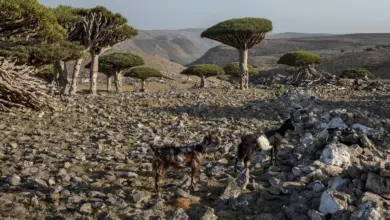Biodiversity refers to the variety of plant and animal life in a given habitat, but for many Egyptians it is the diversity of incorrect definitions of the term that stands out.
Al-Masry Al-Youm conducted a survey asking high school and university students, as well as a selection of random adult pedestrians in Cairo, what they thought “biodiversity” meant. The results were diverse indeed.
“The science of keeping sheep and cows apart;” “a government program to reduce inbreeding;” and “the number of races in a city,” were some of the more notable answers. Many modestly conceded, “I don’t know, to be honest.” But for the most part, a vague reference to “the diversity of plants and stuff” was a common response.
Their are two explanations for this fuzzy understanding.
“The very term is itself quite obscure,” says Hala Barakat, the president of Nature Conservation Egypt.
Barakat says that even events and seminars purporting to deal with the topic often address issues irrelevant to biodiversity itself, further confusing audiences.
At the same time, she suggests that because the term itself is currently fashionable, people are encouraged to use it, but only vaguely and in a way that dilutes the issues.
“There is a knowledge gap between people who work in biodiversity and the public,” Barakat says, “even the concerned public.”
Semantics aside, another reason for the lack of awareness has to do with the fact that Egypt is far from full of savannahs, let along jungles. Egypt is, for the most part, a desert. Visually rich biodiversity–except in the Red Sea–is therefore limited, and often confined to remote locales.
It is not only Egypt where biodiversity remains a cryptic issue. There is a worry among conservationists that in a world where climate change is becoming increasingly acknowledged as the number one threat to humanity, saving biodiversity is being moved further and further down the global to-do list.
It may be partly for this reason that the United Nations has declared 2010 to be the International Year of Biodiversity. The idea is to help raise awareness of its importance through various activities and events around the world.
The year coincides with the 2010 Biodiversity Target–a global conservation mission launched in 2002 at the World Summit on Sustainable Development. It called for “the achievement by 2010 of a significant reduction in the current rate of loss of biological diversity.”
The target was not only missed, it was largely ignored. The findings of a paper recently published in the journal Science present the first assessment of achieving the 2010 target. The study found that contrary to any expected reduction in the decline of biodiversity, the rate was actually rising at an alarming pace. World leaders have failed miserably.
Joseph Alcamo, the United Nations Environment Program’s chief scientist, summarized the gravity of the situation: “Since 1970, we have reduced animal populations by 30 percent, the area of mangroves and sea grasses by 20 percent and the coverage of living corals by 40 percent.”
According to Egyptian environmental consultant Sherif Baha Eddin, “Our situation here is even worse.” Eddin believes that if the rate of decline continues on the current trend, Egypt will lose most of its biodiversity within 20 years.
Already, half of the 500 plant species along Egypt’s Mediterranean coast have disappeared since development began along the shoreline. Much of the coastline has become an “urban wasteland,” says Baha Eddin. “Fifty percent of it is gone.”
Sea turtles that laid their eggs along the North Coast have likewise disappeared from the region, going elsewhere or being confined to northern Sinai. Some conservationists believe this phenomenon is directly linked with the increase in jelly fish in the North Coast–a regular prey for sea turtles.
The real concern now is over the fate of the Red Sea coast, where much of the marine life is unique to the region.
“A lot of the flora lost along the Mediterranean can be found elsewhere,” said Barakat, “but if we develop the Red Sea in the same unsustainable way as the North Coast, the marine life there will be lost forever.”
Even more worrisome is the fact that there are few resources to study the state of biodiversity in Egypt. While it is clear that the situation is bad and getting worse, to what extent is largely a mystery. Research is limited and crucial sites are often closed to visitors and researchers alike.
“The last survey of Gebel Elba (one of the richest habitats in south east Egypt) was in the 1960s,” says Barakat, “It’s shut off by the military most of the time.”
The details of Egypt’s biodiversity may be vague, but conservationists are clear about their biggest threats: urbanization and hunting.
Even attempts to better sustain urbanization by using renewable energy may backfire. The battle against climate change may actually further threaten biodiversity.
An example of this can be seen in wind farms north of Hurghada. If the intended expansion of the wind farms continues, environmentalists fear they may seriously disrupt the flight patterns of the millions of migratory birds that cross the area each year.
But even without wind turbines in their way, birds often don’t make it to their final nesting place. They are shot down in the hundreds of thousands each year over the North Coast and the oases. Bahaa Eddin says that while this is lamentable, at least it is for food, not sport.
The bright side of all this is that Egypt’s 28 protectorates are distributed in such a way that covers most of the remaining important habitats. What remains is ensuring that these areas actually provide the wildlife protection they are meant to.
“Many protectorates are more so based on paper work rather than reality,” says Bahaa Eddin. “The law is often not enforced in these areas.”
For Bahaa Eddin and other conservationists, the sad reality is that Egypt’s biodiversity may be long gone before the term becomes known to most Egyptians.




